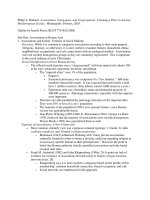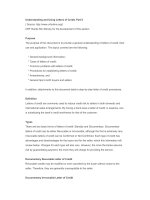Tài liệu Golf and the game of leadership 4 pptx
Bạn đang xem bản rút gọn của tài liệu. Xem và tải ngay bản đầy đủ của tài liệu tại đây (223.28 KB, 10 trang )
20
Golf and the Game of Leadership
figured that a round of golf was finished when the Scotch ran out.
Hence, 18 holes. Fact or fiction, I like the story!
A Tough Course
The model for the Global Leadership Course discussed in this
book is the Black Course of the historic Inverness Club in Toledo,
Ohio. Inverness was originally designed by the late Scottish-born
architect, Donald Ross. It is recognized as one of America’s great
golf courses. Most of the golfing greats have strolled the fairways
of Inverness during its long history. It has been selected as the site
for the 1920, 193l, 1957, and 1979 USGA Open Championships,
the 1973 USGA Amateur Championship, the 1986 and l993 PGA
Championships, and the 2003 USGA Senior Open Championship.
At first glance, Inverness appears to be a simple golfing layout.
But ask a club member or any of the professionals and top ama-
teurs who have played the course and they will tell you that Inver-
ness is a very difficult course. Long par-4s, narrow fairways, and
small, fast, undulating greens create a true golfing challenge. In-
verness is a difficult golf course to play but a prestigious one. It is
an appropriate model for the Global Leadership Course, which is
also more difficult to play than it first appears but when played
well rewards the leader who wishes to achieve the status of a ‘‘real
leader.’’
Low scores in the game of golf most often result when players
do a good job at three aspects of the game. They are:
1.
Keeping the ‘‘ball in the fairway’’
2.
Hitting ‘‘greens in regulation’’ (which means using no
more than two shots on a par 4 and three shots on a par 5
hole)
3.
Having a good ‘‘short game’’ (which is pitching and put-
ting)
These essentials, especially her outstanding short game, led to
the unlikely victory of twenty-four-year-old Hilary Lunke in the
.......................... 10589$ $CH2 02-23-04 16:44:17 PS
21
Simple . . . yet Difficult
2003 U. S. Women’s Open. The 6,550 yard Pumpkin Ridge Witch
Hollow course in North Plains, Oregon, site of the Open, was the
longest course in U.S. Women’s Open history. Lunke, whose driv-
ing distance average is one of the shortest on the LPGA Tour had
difficulty hitting greens in regulation due to the course length but
did well keeping the ball in the fairway and won with masterful
pitching and putting. In the three-way playoff for the champion-
ship, Lunke took only 23 putts for the 18 holes. She told the Asso-
ciated Press, ‘‘I did not have 100 percent of my ball-striking. But
I had 150 percent of my putting.’’ Such extraordinary perform-
ance in one aspect of the game led to Lunke’s victory. However,
her success over time, and that of any other golfer, rests on consis-
tent performance in all aspects of the game.
Leadership is also a simple game. Its essence, like that of golf,
is skilled execution of key fundamentals. Management guru Peter
F. Drucker says common sense is the foundation of leadership.
But common sense is not so common. Leaders too often seem to
work very hard at making the game of leadership unnecessarily
difficult. Drucker further points out that, not unlike golf, leader-
ship is centered on the integration of three central ingredients,
‘‘contribution to the mission of the organization, concentration
on key tasks, and commitment to professional standards of per-
formance.’’
Golf and the Game of Leadership is about hitting quality shots
in the leadership game from wherever your responsibility lies. It
is about helping you to stay in the leadership fairway. Just as the
golfer concentrates on achieving the right results with each swing
of a golf club, so too the leader’s energy must be concentrated on
accomplishing the right results.
Challenge at General Motors
Maryann Keller, in her book Rude Awakening: The Rise, Fall and
Struggle for Recovery of General Motors, wrote, ‘‘What kind of
place is [General Motors] really? . . . It might surprise you to learn
it’s the kind of place great novels are made of, full of drama,
intrigue, and high adventure. What goes on here may well be the
.......................... 10589$ $CH2 02-23-04 16:44:17 PS
22
Golf and the Game of Leadership
ultimate example of the heartbeat of American business. GM is a
study in many of the things that are right about corporate
America . . . and much that is wrong.’’
1
In the mid-to-late 1980s, GM, faced with increasing competi-
tion and technological challenges, was going through major
change in every aspect of its business. The corporation was build-
ing new plants, revamping old ones, introducing robotics, retrain-
ing the workforce, trying a new method of operating (in Saturn),
and reorganizing on a massive scale. In one organizational re-
alignment more than 200,000 employees changed organizational
identities in a single day.
A McKinsey and Company study, commissioned by GM, con-
firmed that the systemic changes were essential but found other
aspects of the business that needed attention. Specifically, the or-
ganization’s leadership culture needed to change. It was as if GM
was building new golf courses, revamping old ones, requiring the
use of new golf equipment, training the caddies and grounds
crews, and reorganizing their country clubs. All at the same time.
But, they were not helping the leadership adapt to the changes
affecting their game.
Task forces were assembled to set specific goals for imple-
menting McKinsey’s recommendations. One task force looked at
the matter of executive development. A resulting objective was to
develop a core GM-specific leadership development program for
the top 500 executives. This assignment fell to the corporation’s
manager of executive development, Bill Haupt. GM’s education
and training department (GME&T) was technically competent to
build the program, but it recognized the need to have a credible
outside partner. They chose the Forum Corporation, based in
Boston.
In the two-week period just before Christmas 1985, Dr. Wil-
liam M. DeMarco, Forum’s senior project consultant, and Bill
Haupt traveled the country interviewing a diagonal slice of forty-
five upper-level GM executives. Three basic questions were at the
heart of the interviews:
.......................... 10589$ $CH2 02-23-04 16:44:18 PS
23
Simple . . . yet Difficult
■
What words would you use to describe GM today?
■
How would you like to be able to describe GM as we enter
the twenty-first century?
■
What is getting in the way?
Simple Answers
The answers were remarkable. Remarkably simple! Every person
asked—man or woman—said in response to the last question,
‘‘We are.’’ Surprisingly, they did not blame unfair trade with
Japan, government regulations, the attitudes of the workforce, the
union(s), or provide any other lame excuse. They were leaders.
They knew that to get different results they had to lead differently.
They knew the answer was leadership. That was simple. They also
admitted they did not know quite how to change. That was diffi-
cult.
GME&T and Forum then developed a ‘‘culture change’’ train-
ing course for GM’s top 3,000 managers. The effort was originally
entitled ‘‘Leadership 21.’’ But the pilot group, demonstrating an
uncommon sense of urgency, seized ownership and demanded the
program be called ‘‘Leadership NOW.’’ Then in a move I greatly
appreciated, Bill Haupt and his boss, Ralph Frederick, director of
GME&T, invited me to partner with Forum’s lead facilitator,
Marc Sarkady, in the conduct of the program.
We ran the first pilot in late 1986. Then we ran 102 groups in
the United States, plus twelve groups in Europe. We finished in
1990. As I recall, the total number of participants was between
2,900 and 3,000. Participants came from all functional areas and
all parts of the GM system.
I estimate that more than thirty corporate officers and other
top-level executives served as evening discussion leaders. Many
follow-up Walk-the-Talk workshops were also conducted.
What is remarkable is that the GM program administrators
never had top level permission to do any of it! They got an okay
to run a pilot and just never stopped. Their bosses just let them
do it. It is indeed easier to get forgiveness than permission.
.......................... 10589$ $CH2 02-23-04 16:44:18 PS
24
Golf and the Game of Leadership
A Course Change
Did ‘‘Leadership NOW’’ by itself change GM’s culture? Of course
not! But did it contribute to the push for needed culture change?
Absolutely! General Motors is like one of our modern giant cruise
ships. If you want to change the course of one of these vessels, the
officer-of-the-deck orders a change to the angle of the rudder.
The rudder angle changes the course degree by degree, and it is
readjusted from time to time until the new course is reached.
‘‘Leadership NOW’’ was a one-degree change in the movement of
GM to a new course, a new culture. It gave impetus to the many
changes that have followed since.
According to Maryann Keller:
Executives who attended the sessions experienced initial cul-
ture shock as they were asked to drop their inhibitions and
relate to one another with complete trust . . . anonymous em-
ployee evaluations were discussed openly in sessions . . . words
like ‘‘open’’ and ‘‘honest’’ were used frequently. It was a very
different experience for the people at General Motors—part
sensitivity training, part personal empowerment. The tone of
the sessions threw people off guard—they were the epitome of
everything GM had never been.
2
Since the time of Leadership NOW, GM has made significant
strides in its culture and products. So has their competition. And
the struggle continues. One thing appears evident, GM is trying
to eliminate, or reduce, unnecessary internal actions that increase
the difficulty of the task. The corporation is searching for simplic-
ity of operation as it competes in the global car and truck market-
place.
The approach of Jack Smith and Rick Wagoner as leaders of
GM has greatly simplified GM’s business approach. The emphasis
is back to engineering, building, and selling ‘‘great cars and
trucks.’’ The ‘‘frozen middle,’’ a term coined by former GM
Chairman Roger Smith to describe an unmotivated middle-
management group created in no small part by the actions of top
.......................... 10589$ $CH2 02-23-04 16:44:19 PS









